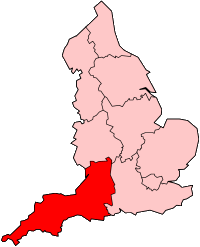|
Winfrith
Winfrith Atomic Energy Establishment, or AEE Winfrith, was a United Kingdom Atomic Energy Authority site near Winfrith Newburgh in Dorset. It covered an area on Winfrith Heath to the west of the village of Wool between the A352 road and the South West Main Line. Winfrith was set up in order to test a variety of new nuclear reactor designs with the intention of selecting a new design for power generation and other tasks. The main design built at the site was the demonstration steam-generating heavy water reactor (SGHWR) providing power to the National Grid. A number of smaller designs were also constructed at the site. The site officially opened with the ZENITH reactor in 1960. SGHWR opened in 1967 and was shut down in 1990. All of the reactors have been shut down and are in various stages of removal. The site is now being re-used for other purposes while decommissioning continues. Nuclear researchThe initial steps that led to the formation of Winfrith began with the creation of the United Kingdom Atomic Energy Authority (AEA) from the former Atomic Energy Research Establishment (AERE) in 1954. John Cockcroft, in charge of the Research Group, immediately began pressing for a new site to be set aside for the construction of multiple experimental reactors, with the aim being to try many designs in order to develop the best possible commercial systems. This was opposed by Christopher Hinton, of the Industrial Group, who wanted to pick a single design and focus their energies on that. Cockcroft eventually won the acrimonious argument.[1] The site in Dorset was selected and led to the formation of the opposition group, the Dorset Land Resources Committee, led by Colonel Joseph Weld. The AEA were granted planning permission for the development by Dorset County Council, which was confirmed by a public inquiry, but during the process it was discovered that various rights of common may have existed over the land. In order to enable the development to go ahead as quickly as possible, the government introduced, and Parliament passed, the Winfrith Heath Act 1957, extinguishing any rights of common over the land, and allowing for a compensation process for any commoners whose rights had been extinguished.[2] The AEA acquired 650 acres by compulsory purchase order and another similar size through normal purchases to bring the site to 1,350 acres. To house the staff, they also purchased 153 homes in Bournemouth and Poole for staff to rent, as well as 127 in Weymouth, 100 in Dorchester, 24 in Wareham and 12 in Wool. The Durley Hall Hotel at Branksome Chine was bought in 1958 for single staff and temporary accommodation.[3] Construction began in 1957, and the first low-energy reactor, ZENITH, was completed and in operation by the end of 1959.[4] The site did not officially open until 16 September 1960. This was quickly followed by two new reactors, NESTOR in 1961 and DIMPLE in 1962.[4] Many others followed.[3] Cockcroft also suggested that larger fusion reactors be built at Winfrith, but this was met by serious pushback from the scientists involved in the programme. This work instead moved to today's Culham Centre for Fusion Energy. Staffing peaked at 2,350 in 1966, but the site slowly wound down and the staff was 1,800 by 1978. The largest reactor at the site (SGHWR), closed in 1990, and the site turned primarily to disposal of nuclear waste. In 1995 the eastern part of the site became the Winfrith Technology Centre, and 218 acres on the western side were decommissioned. The last reactor was shut down in 1995, although decommissioning of the site will not finish till 2021.[5] Winfrith housed several experimental reactors during its lifetime. There were also impact test facilities, and a used nuclear fuel examination facility with the associated hot cells. Experimental reactors included:
Winfrith Steam Generating Heavy Water ReactorDesignThe largest reactor at Winfrith was a steam-generating heavy water reactor (SGHWR) commonly known as the Winfrith Reactor.[4] It was designed by the UKAEA, and was intended to combine the features of the CANDU reactor and PWR.[13] The core consisted of a bank of metal pressure tubes (zirconium alloy) which passed through vertical tubes in a tank of heavy water moderator – allowing the designers to do without the pressure vessel that normally contained the reactor's core.[14] The pressure tubes contained the fuel which was cooled by a flow of light water up the tubes, generating steam.[14] The fuel was slightly enriched uranium.[14] The power level was varied by the level of the moderator.[15] The reactor exported up to 100 MW of electric power to the National Grid.[14] For many years it was the largest water cooled reactor in the United Kingdom.[4] HistoryConstruction of the reactor began in 1963.[4] It began operating in 1967,[15] and was notable for being built within the allotted timescale (four years), and for being under-budget.[16] It was built as a demonstration reactor,[15] with the intention of building a series of commercial reactors based on the design.[13] However, the SGHWR design was never advanced beyond the prototype at Winfrith,[15] and the design was sidelined in favour of AGR reactors.[13] The Winfrith reactor was shut down in 1990.[15] The site todayThe site is now split between the nuclear licensed site, the extensive Dorset Innovation Park (formerly Winfrith Technology Centre) and the headquarters of the Dorset Police. Ownership of the Winfrith Nuclear site has now passed to the Nuclear Decommissioning Authority (NDA). The site is managed by Magnox Limited,[5] who are contracted to deliver the site decommissioning programme. In 2022 over 1000 drums of radioactive waste from the Steam-Generating Heavy Water Reactor will be transported by 11 trains to the Low Level Waste Repository. The material was once intermediate-level waste but had decayed down to low-level waste while being stored at Winfrith.[17] See alsoReferencesCitations
Bibliography
External links
|
||||||||||||||||||||||||||||||||||||||||||


